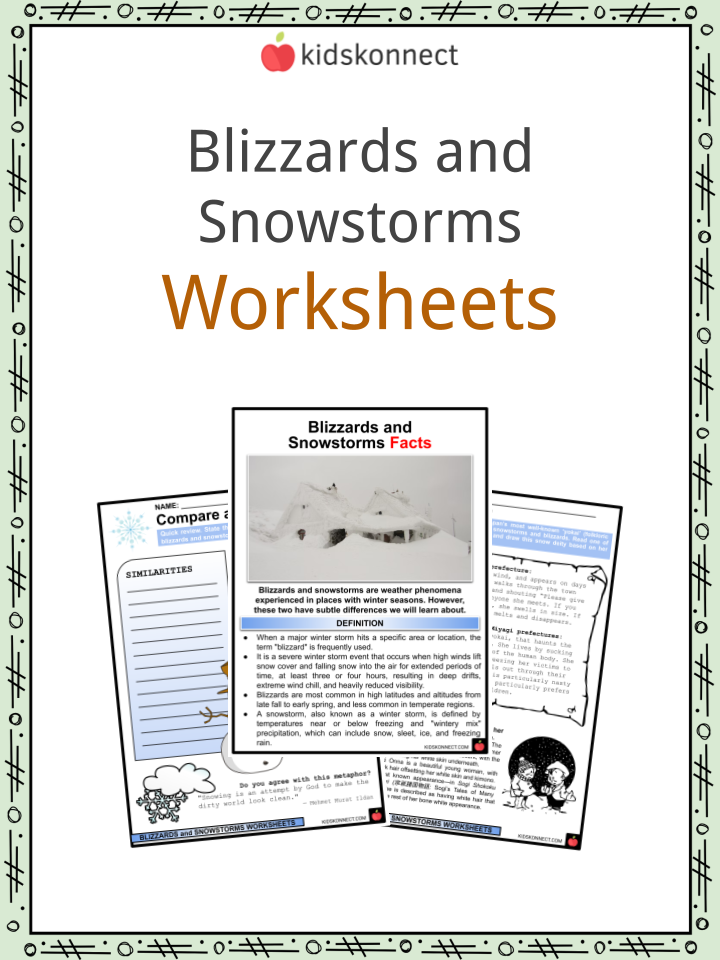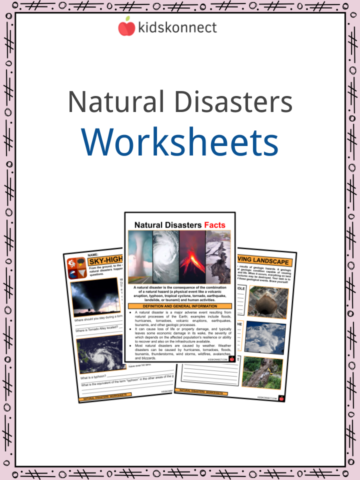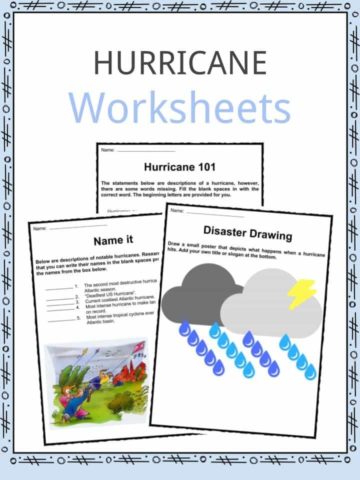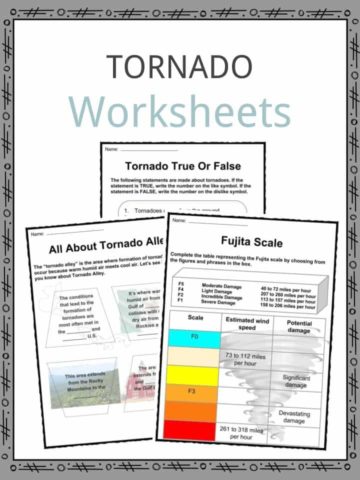Download This Sample
This sample is exclusively for KidsKonnect members!
To download this worksheet, click the button below to signup for free (it only takes a minute) and you'll be brought right back to this page to start the download!
Sign Me Up
Table of Contents
Blizzards and snowstorms are weather phenomena experienced in places with winter seasons. However, these two have subtle differences we will learn about.
See the fact file below for more information on Blizzards and Snowstorms, or you can download our 29-page Blizzards and Snowstorms worksheet pack to utilize within the classroom or home environment.
Key Facts & Information
DEFINITION
- When a major winter storm hits a specific area or location, the term “blizzard” is frequently used.
- It is a severe winter storm event that occurs when high winds lift snow cover and falling snow into the air for extended periods of time, at least three or four hours, resulting in deep drifts, extreme wind chill, and heavily reduced visibility.
- Blizzards are most common in high latitudes and altitudes from late fall to early spring, and less common in temperate regions.
- A snowstorm, also known as a winter storm, is defined by temperatures near or below freezing and “wintery mix” precipitation, which can include snow, sleet, ice, and freezing rain.
SIMILARITIES AND DIFFERENCES
- Blizzards and snowstorms are two somewhat similar events concerning weather and snow but with some minor differences.
- A snowstorm is a type of weather that includes rain, ice formation, snowfall, and sleet. A snowstorm is also known as a winter storm when temperatures drop below freezing.
- A blizzard is a severe snowstorm accompanied by high winds. In other words, a blizzard is simply an extremely severe snowstorm.
- Winds of 35 mph or higher must be present for three hours for a snowstorm to be classified as a blizzard. Thus, an individual must be unable to see more than a quarter mile ahead due to poor visibility.
- While snowstorms can become blizzards if the winds are powerful enough, they aren’t necessarily destructive or dangerous.
- Blizzards, unlike snowstorms, blow the snow around so much that they may leave very little behind.
- Snowstorms can also occur in the autumn and winter, whereas blizzards can only occur in the winter. To summarize, blizzards require strong winds and poor visibility, and the difference has nothing to do with the amount of snow.
FORMATION
- A snowstorm occurs when precipitation falls as snow.
- Since temperatures at the top of the storm are cold enough to form snowflakes, most precipitation in winter falls as snow within the clouds.
- Snowflakes are collections of frozen ice crystals formed when water vapor condenses and freezes into water droplets.
- They are also typically formed when different types of air masses interact in the mid-latitudes. These storms are fueled by temperature and moisture differences.
- Snow storms are typically driven by an increase of moist air within an intense tropical cyclone (low-pressure area), which forces a relatively warm, moist air mass up and over a cold air mass.
- If the air near the surface is not sufficiently cold over a deep enough layer, the snow will fall as rain.
- Because these intense tropical cyclones or low-pressure areas are also surrounded by wind, strong winds can develop into stronger storms, sometimes resulting in blizzard conditions.
- The total amount of snowfall produced by a snowstorm is determined by how quickly warm air rises above cold air, how much water vapor is readily accessible to form precipitation, as well as how fast the storm moves.
- Meanwhile, blizzards form when a winter weather system combines heavy snowfall with high winds or when a winter windstorm hits an area that has recently received heavy snowfall.
- Blizzards can form in a wide range of weather conditions, but they are most likely to form when cold polar air collides with a warm, humid front.
- A blizzard can form when the air temperature is near or below freezing point. It also occurs at higher latitudes when cold winds from the poles blow south, and warm winds from the tropics blow north.
EFFECTS OF SNOWSTORMS AND BLIZZARDS
- Blizzards and snowstorms have a number of effects on humans, including the closure of cities and transportation networks, property damage, economic harm, and injuries and fatalities.
- Blizzards can also cause extensive property damage due to roof collapses, broken windows, and tree damage to cars and homes.
- Furthermore, heavy snowfall can cause traffic accidents due to road closures and malfunctioning traffic signals.
- Extreme weather conditions such as snowstorms and blizzards cause car accidents and people on foot to become disoriented.
- Blizzards and snowstorms also cause colder temperatures, increasing the risk of frostbite or hypothermia.
- Skin exposed to such weather extremes may lose all sensitivity within minutes. These health issues can affect a person, necessitating urgent medical care, which may be hampered by the weather.
- Because not everyone is well-equipped to deal with a blizzard, it is best to stay indoors during such severe weather.
- Animals can become trapped in blizzards, unable to flee danger. They may also become disoriented after being snowed in. Many animals will seek shelter from the storm inside buildings, which can also be hazardous to humans.
- Most animals that hibernate are fortunate enough to take shelter or find refuge beforehand or during a blizzard. However, some animals are not so fortunate.
- If a snowstorm is intense enough to destroy the shelter that animals rely on, it harms their habitat and potentially leaves them with nowhere else to shelter and wait out the storm.
- All this being said, even if animals survive an intense snowstorm, they are frequently confronted with the blizzard’s most difficult challenge, the aftermath.
- Given that so many different wildlife species rely on the plant life in their region for survival, they may be put in jeopardy if there is no food to eat once the storm passes.
- In terms of environmental damage, blizzards and snowstorms can cause havoc on plants and trees, destroying natural features and killing crops due to the extreme cold.
- Flooding can occur even after a blizzard has ended due to excessive snowfall.
- When temperatures rise significantly after a blizzard, snow melts faster than the land can absorb it, resulting in flooding.
- The humid and damp conditions created by an extended blizzard and snowstorm periods may cause some fungi to damage the environment by destroying plants and trees that provide food that is important to the survival of the local ecosystem.
- Furthermore, the extremely cold temperatures brought by blizzards can have a negative impact on the soil.
- Soils prefer a consistent annual temperature that fluctuates predictably.
- When soil is subjected to extremely cold temperatures for extended periods of time, the level of fertility within the soil can suffer.
- This will eventually lead to erosion, which is bad for the nutrients in the ground.
- Blizzards can also contribute to a large buildup of water vapor in the atmosphere, resulting in more rain and storms throughout the rest of the year.
- Depending on their severity, these storms raise water levels and have an impact on plant and animal populations.
Blizzards and Snowstorms Worksheets
This fantastic bundle includes everything you need to know about Blizzards and Snowstorms across 29 in-depth pages. These ready-to-use worksheets are perfect for teaching kids about Blizzards and Snowstorms, a weather phenomenon experienced in places with winter seasons.
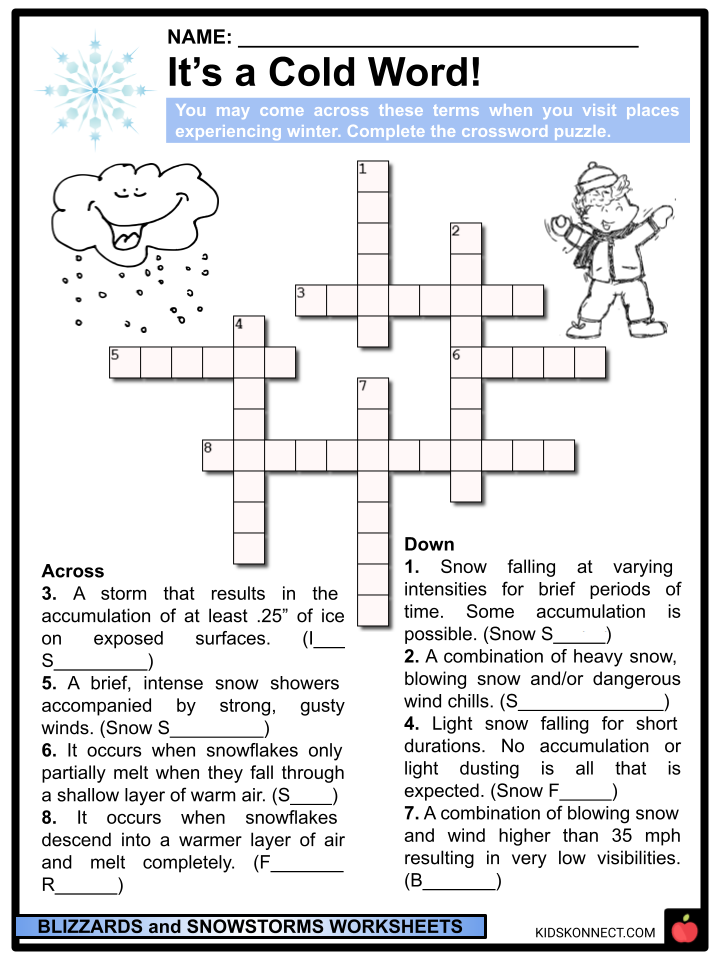
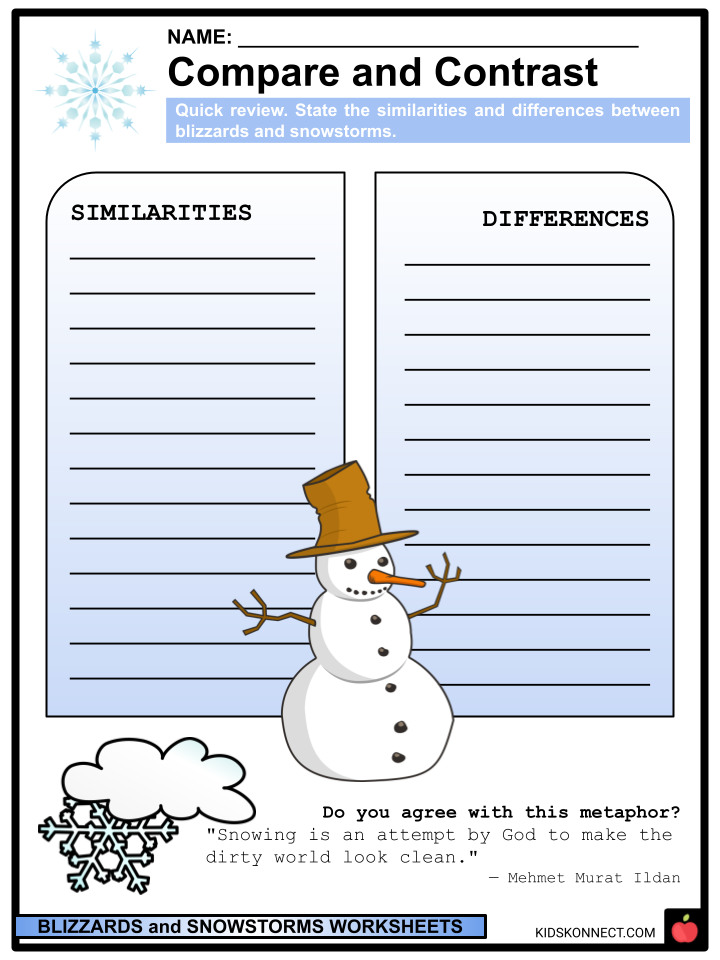
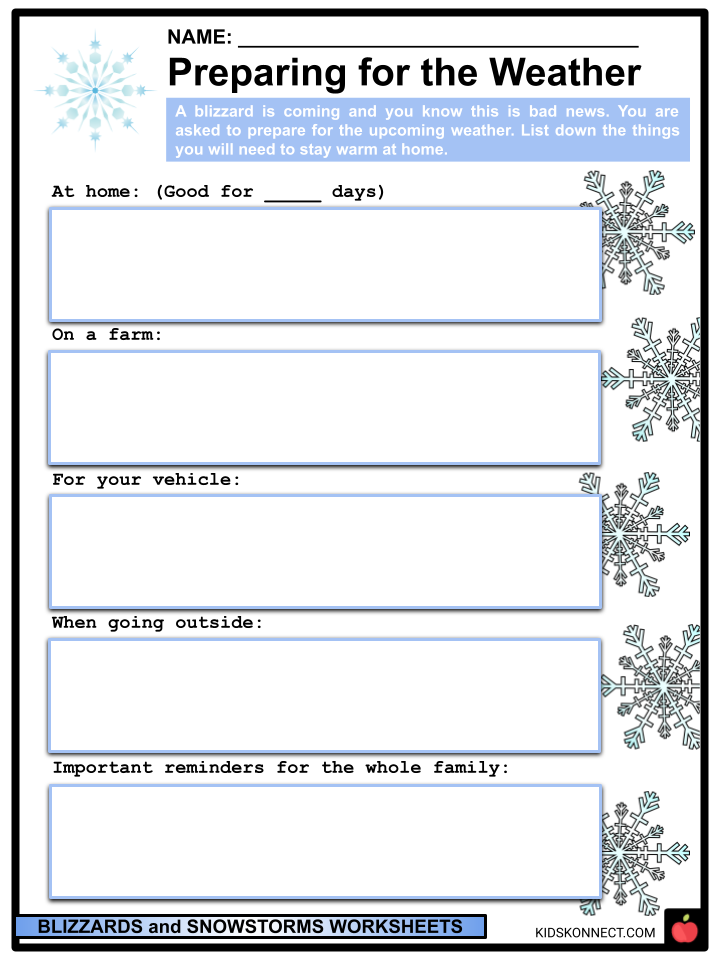
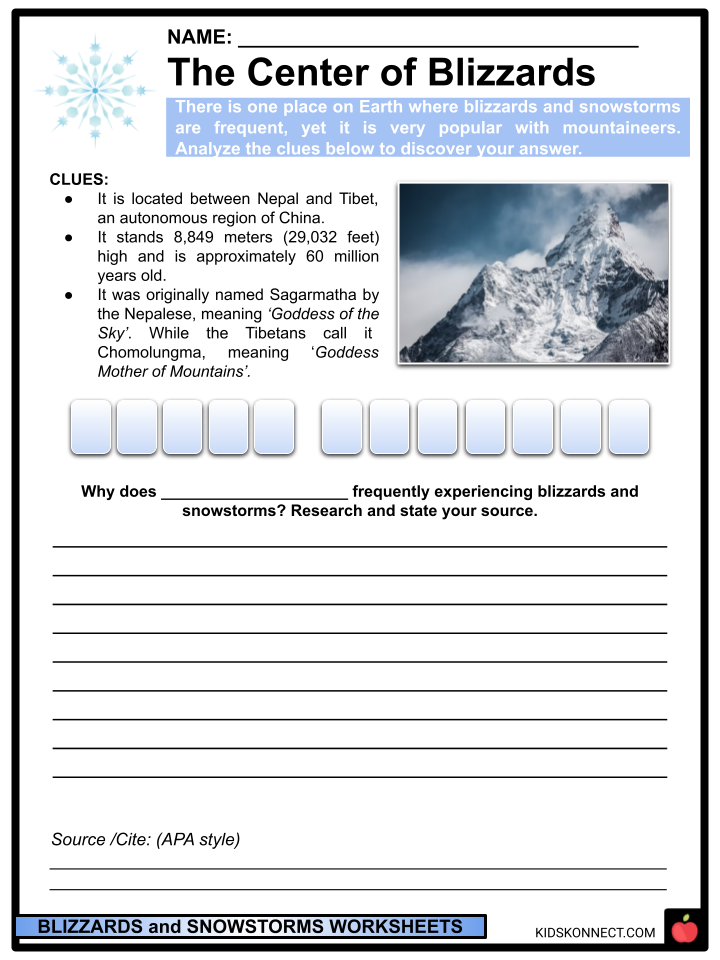
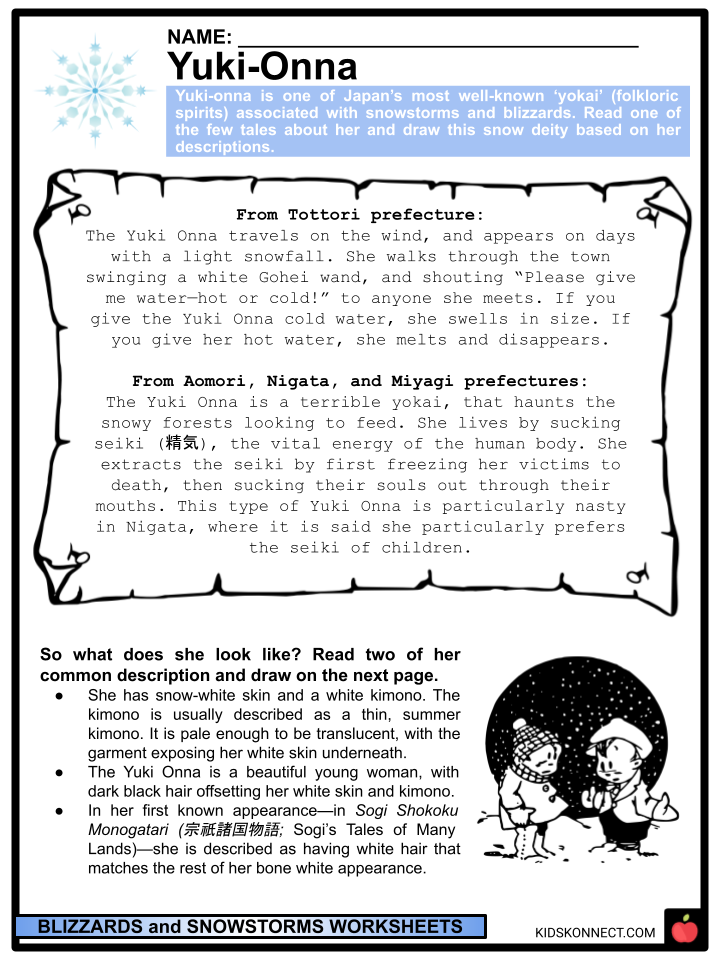
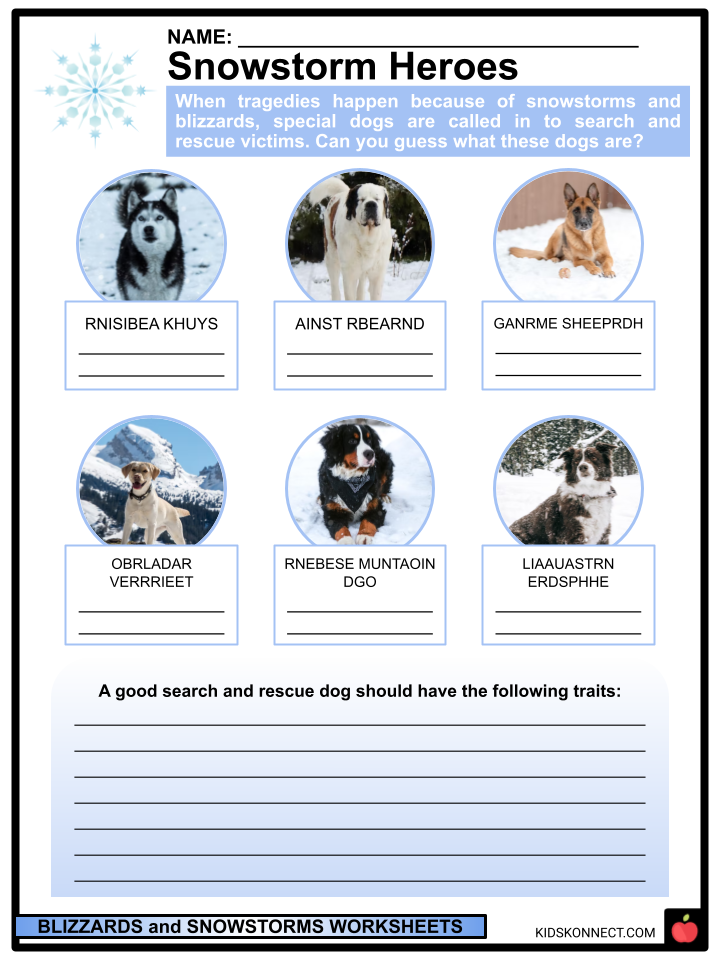
Complete List of Included Worksheets
Below is a list of all the worksheets included in this document.
- Blizzards and Snowstorms Facts
- It’s a Cold Word!
- Compare and Contrast
- Snowy Illustration
- Preparing for the Weather
- Record Breaking Blizzards
- The Center of Blizzards
- Yuki-Onna
- Snowstorm Heroes
- Fact or Fiction?
- Snow Arts
Link/cite this page
If you reference any of the content on this page on your own website, please use the code below to cite this page as the original source.
Link will appear as Blizzards and Snowstorms Facts & Worksheets: https://kidskonnect.com - KidsKonnect, January 9, 2022
Use With Any Curriculum
These worksheets have been specifically designed for use with any international curriculum. You can use these worksheets as-is, or edit them using Google Slides to make them more specific to your own student ability levels and curriculum standards.
